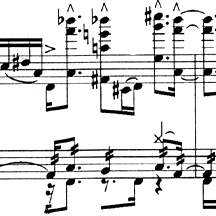|
|
||||||||||||
|
|
|
|
|
|
|
|
|
|
|
|
|
|

=back
Luciano Berio, Sequenza VIIb (1969/93)
The Sequenzas are a series of works for sixteen different solo instruments, including trombone, violin, voice, piano, guitar and accordion, are some of Berio's most famous works. All share a common virtuosic element and are "intended to set out and to develop melodically an essentially harmonic discourse and... a polyphonic mode of listening." Sequenza VII was originally written in 1969 for the oboist Heinz Holliger and was transcribed for soprano saxophone by the composer and Claude Delangle in 1993. Berio has come to prefer this version and plans to rewrite the oboe version with the effects of the soprano saxophone in mind.
Sequenza VIIb could be perceived as a variation on one note, B natural. This pitch sounds quietly through the whole piece from another instrument or synthesizer in order to "lend a weak echo to the solo instrument." From the starting pitch, B, an almost complete chromatic register is gradually introduced. The backbone of the work lies in enharmonic fingerings, multiphonics, articulation, and dynamics. The work can create a truly electrophonic impression.
Luciano Berio has taught at Mills College, Harvard University, and the Juilliard School. From 1973 to 1980 he headed the electroacoustic department of IRCAM in Paris. In 1960 and 1982 he was composer in residence at the Tanglewood Music Center, and in 1993-94 delivered the Norton Lectures at Harvard University. One of the most prolific and influential composers of the late twentieth century, Berio has received many commissions, prizes, and honorary degrees, and has composed for voice, symphony orchestra, music theater, and solo instruments, as well as exploring electronic and digital processing of sound. He has also transcribed and adapted works by composers ranging from Monteverdi to Mahler, and collaborated with major Italian literary figures including Italo Calvino and Umberto Eco.
=back
| © Yesaroun' Duo |